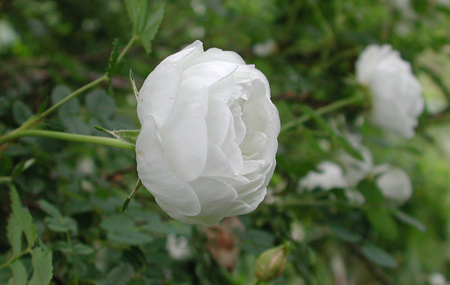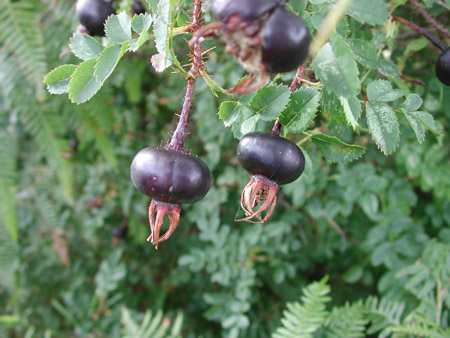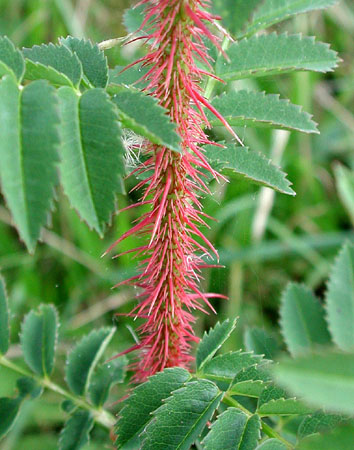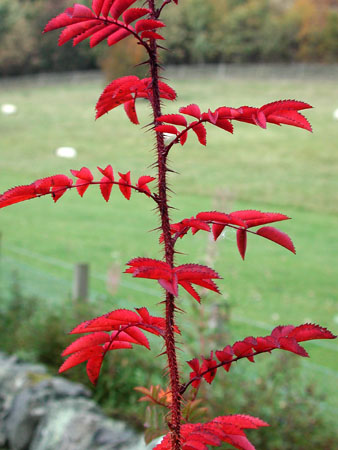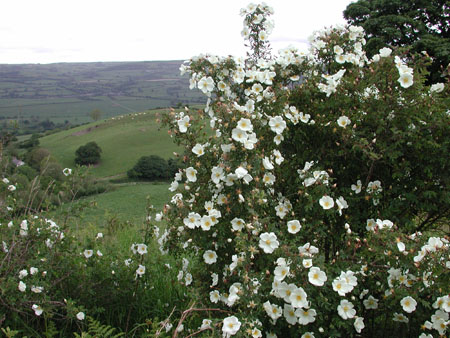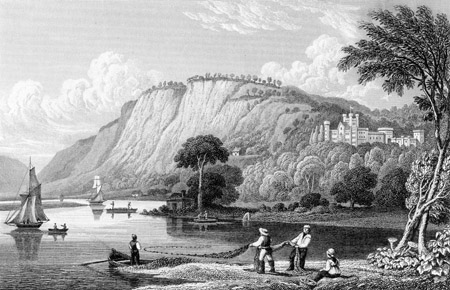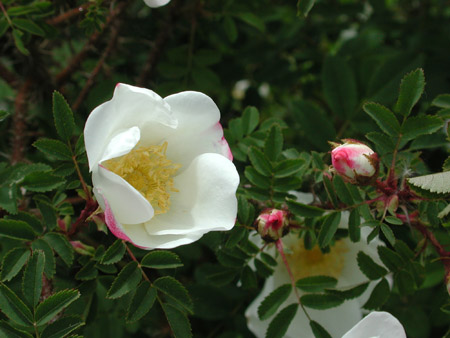This approach
is a useful way of examining the similarities and differences within Spinosissimas,
but in this article I will examine Scots Roses and other hybrids of Rosa
spinosissima in groups according to the colour of the flowers. Although
at first sight, this may seem a rather simplistic approach, it is one that
has practical value for the gardener and is a useful way of examining the
origins of cultivars named in this article and relationships between them.
White
and cream-coloured Scots Roses
Included
among white and cream-coloured Scots Roses are wild forms of Rosa spinosissima
from different parts of its geographical range and some that have a hybrid
origin.
Rosa
spinosissima as sold by British nurseries may include the low-growing
form that grows on sand dunes but, possibly more often, taller growing 'Grandiflora'
types that may have been imported from European nurseries or grown from
imported seed of Central European forms. The name R. spinosissima
'Grandiflora' covers cultivated variants of R. spinosissima with
larger leaves and flowers than those of typical Scots Roses, and includes
R. spinosissima 'Altaica'. They are also taller growing, often
have fewer bristles and have a more upright arching habit than the coastal
forms. Some definitely originate in Asia but other forms may come from parts
of inland Europe.
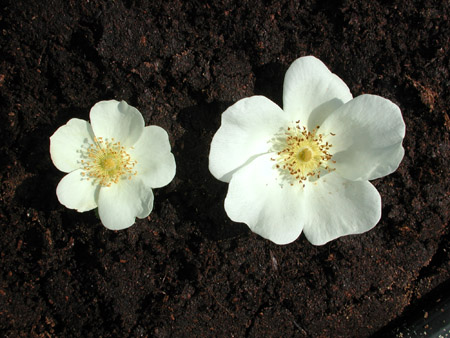
Flowers of a
wild British R. spinosissima and R. spinosissima 'Grandiflora'.
Some forms of 'Grandiflora' have even larger flowers.
Any of these
British, mainland European or Asian plants might be styled 'Single White'
in a nursery catalogue but may show some yellow in the centre of the flower
or even tend towards a cream colour. Seed-grown plants show considerable
variation and R. spinosissima plants sold for hedges often comprise
or include 'Grandiflora' forms that may grow to over 2 m. tall. R. spinosissima
'Grandiflora' and R. spinosissima 'Altaica' are often treated as
being synonymous. However, although the Asian 'Altaica' is a 'Grandiflora'
type, there are selected forms called 'Altaica' that are superior garden
plants. Some 'Grandiflora' types may actually be hybrids and I have seen
several forms that have a hint of R. foetida in their scent while
otherwise looking like R. spinosissima.
Rosa
spinosissima 'Hispida' is a name that covers a bristly-stemmed
group of forms from Asia with larger, more cream coloured flowers than the
typical western European form of the species. Plants that I have under this
name have very shiny black fruits that are conspicuously broader than long.
It has very good autumn colour. It is a very beautiful rose for much of
the year, whether in flower or not.
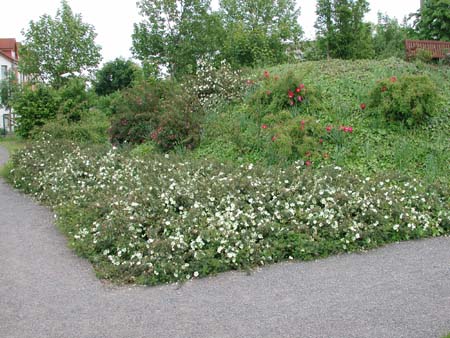
Rosa
'Compactilla' growing as groundcover at the Europa-Rosarium, Sangerhausen,
Germany
'Compactilla'
is a low growing single white cultivar used for ground-cover plantings in
Europe. It may originate as a sand dune form. Double White is a name,
sometimes styled as a cultivar name (i.e. 'Double White') that is
applied to numerous different semi-double and double forms. 'Dunwich
Rose', a name that is common in nursery lists, was a local name for
the ordinary wild R. spinosissima in the region of Dunwich, Suffolk,
England since at least the early 19th century. However, a 1917 account of
the 'Dunwich Rose' by Viscount Dunwich describes this rose as a variety
having semi-double white flowers with a tinge of yellow, borne in groups
of three. This latter characteristic indicates a hybrid as the flowers of
R. spinosissima are borne solitarily. Therefore, the single-flowered
rose sold under this name is not the 'Dunwich Rose' in this selective sense.
However, as the single-flowered plant with this name in my collection does
not set fruits, it is probably also a hybrid.
White flowered
hybrids of Rosa spinosissima include simple species-like hybrids
(R. spinosissima crossed with another species) and complex hybrids
(R. spinosissima crossed with a hybrid rose). They do not have the
characteristics of a typical Scots Rose. Coincidentally, two have an association
with Canada. 'Louis Riel', an attractive hybrid with R. glauca,
combines the flowers of R. spinosissima and the bluish purple foliage
of R. glauca. It was raised in Canada by Stanley Zubrowski in 1996.
'Paula Vapelle' is a repeat flowering, double white rose raised in
Belgium by Ivan Louette in 2002. Named after his mother, it is a hybrid
between 'Stanwell Perpetual' and a wild collection of R. spinosissima
from Brittany in France. It therefore has two portions of R. spinosissima
in its parentage. 'Stanwell Perpetual' is described later with other pink-flowered
roses. Louette immigrated to Canada. There are also a number of old double
white Spinosissimas of European origin that appear to be complex hybrids
because of their comparatively large flowers and a scent unlike that of
R. spinosissima.
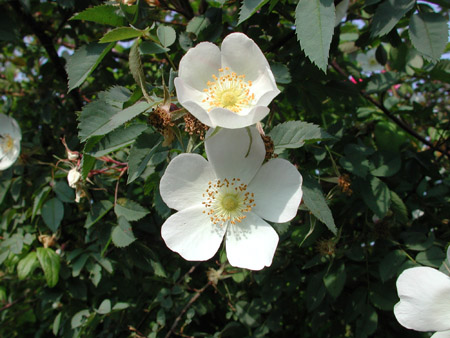
Louis Riel,
a hybrid combining the flower of R. spinosissima and the foliage
of Rosa glauca
Yellow
Scots Roses
The well-known
rose 'Harison's Yellow' has a special significance in the history
of Scots Roses in America. It was a home-grown rose, raised in about 1824
by George Folliott Harison (1777-1846), a New York attorney. Harison sold
a plant of it to William Robert Prince in about 1830 in exchange for a new
Camellia that Prince had imported from Britain. The rose was effectively
a double yellow Scots Rose - a hybrid between R. spinosissima and
R. foetida, but not recognised as such at the time.
The hybrid
between R. spinosissima and R. foetida has been given the
name Rosa x harisonii in honour of George Harison and
his 'Harison's Yellow' but the hybrid probably arose in Britain before 'Harison's
Yellow' because double yellow Scots Roses were in existence from the very
early years of the 19th century, having been raised by Robert Brown in Perth
and Robert Austin in Glasgow.
I am not
certain which of the surviving double yellow Scots Rose cultivars is the
true original 'Harison's Yellow'. The name 'Harison's Yellow' has been made
famous as a rose that was carried across America by pioneer families and
it is still found growing by deserted homesteads along the Oregon Trail.
However, are all these roses the original 'Harison's Yellow'? I have not
been able to explore the Pioneer Trail sites in person but photographs that
I have seen of so-called 'Harison's Yellow' in America as well as plants
sold under the name in Britain and mainland Europe seem to reveal that they
are not all the same cultivar. I suspect that other varieties of R.
x harisonii or seedlings of 'Harison's Yellow' itself may be involved. In
Britain, gardeners and nurserymen have tended to apply one of a small number
of names published in the 20th century rose books to any Scots Rose that
they come across. Has this happened with 'Harison's Yellow' in North America?
Has there been a tendency to name any double yellow Spinosissima within
a certain range of parameters as 'Harison's Yellow'?
Hybrids
similar to 'Harison's Yellow', were raised by Thomas Hogg of New York, Samuel
Feast of Baltimore and possibly others. Seedlings were also raised from
'Harison's Yellow'. William Prince himself commented in 1846 that "numerous
seedlings have been raised from this variety, but all that have come from
under my notice have proved very similar, or inferior to it." It is possible
that old plants of so-called 'Harison's Yellow' include seedlings from 'Harison's
Yellow' or another variety.
I have not
seen a contemporary (1830s) illustration of 'Harison's Yellow' but the variety
'Hogg's Double Yellow' was described by Professor David Don and illustrated
in colour in Sweet's British Flower Garden of 1838. This semi-double
variety "was brought from New York by Mr. James McNab, who received it from
Mr. Thomas Hogg, Nurseryman in that city, by whom the plant was raised from
seeds of the single yellow rose [R. foetida], and it is known in
the nurseries by the name of 'Hogg's yellow American rose'. It is a pretty
variety, but it is surpassed in the fullness of its flowers, and in the
richness of colouring by Williams's double yellow rose."
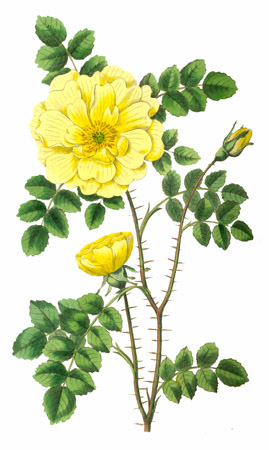
'Hogg's Double
Yellow' from The British Flower Garden by Robert Sweet Vol. 4 (1838),
courtesy the Arnold Arboretum Library
It has been
suggested that 'Hogg's Double Yellow' was in fact 'Harison's Yellow' under
another name and that James McNab had misunderstood its origin. However,
the account seems clear and there is no reason why it should not have been
another variety. Thomas Hogg was an expatriate Scot, born in Berwickshire,
Scotland in 1778 and he emigrated to New York in 1820. His nursery catalogue
of 1834 (the year in which James McNab and Robert Brown visited the nursery)
listed five Scotch Roses and "Harrisonia" (Harisonii) but it does not include
anything that could be 'Hogg's Double Yellow'. Hogg's seedling may not have
been available for sale by that time but by 1843, Hovey and Co of Cambridge,
near Boston, Massachusetts were selling "Double yellow Harrison" (fine yellow,
double), "Hogg's Seedling Scotch" (double, pale yellow) and "Williams' double
yellow" (bright yellow). However, the name of Hogg's plant is not in current
use and both Robert Buist in his Rose Manual (1844) and Prince in
his catalogue treat it as synonymous with 'Harison's Yellow'.
R.
x harisonii 'Williams's Double Yellow' (often called 'Williams
Double Yellow' today) was raised in about 1826, in Pitmaston, Worcestershire,
England. I am not convinced that the plant currently sold as 'Williams Double
Yellow' is the same plant as that originally given the name. A description
by Professor David Don and colour illustration published in Sweet's British
Flower Garden of 1836 shows a cultivar that is superior in flower form
to the plant currently sold under the name. Although the 'William's Double
Yellow' sold today is striking in colour and abundance of bloom, it has
rather messy, poorly formed individual flowers with a green bud in the centre.
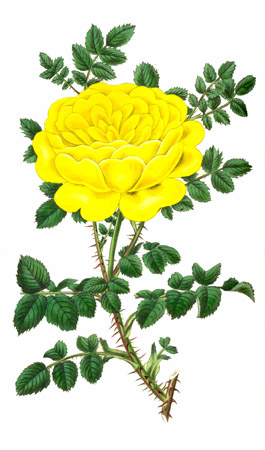
'Williams's
Double Yellow' from The British Flower Garden by Robert Sweet Vol.
4 (1838), courtesy the Arnold Arboretum Library
Many other
forms of R. x harisonii or seedlings of it are in cultivation
today. Some of them are closer to R. spinosissima and others closer
to R. foetida. Double yellow Scots Roses are common in old gardens
in parts of Scotland, often forming a hedge in front of old cottages in
country villages. Plants with the names 'Lutea' and 'Lutea Maxima'
(both single), 'Harison's Yellow', 'Williams Double Yellow'
and 'Old Double Yellow Scotch' are the most readily available forms
from nurseries in Britain, but I have seen other varieties in old gardens
in Scotland.
Even more
single, semi-double and double yellow cultivars are grown in Scandinavia,
Finland and Germany, but some of these appear to be hybrids with 'Altaica'
or other 'Grandiflora' types of R. spinosissima, unlike Scots Roses
in habit .
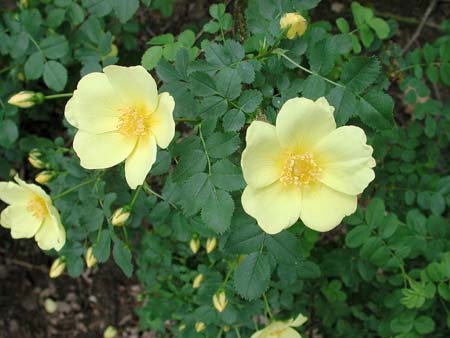
A single form
of R. x harisonii
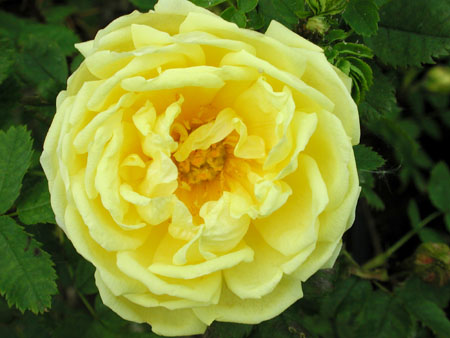
One
of many single and double hybrids between R. spinosissima and R.
foetida (i.e. a form of Rosa x harisonii)
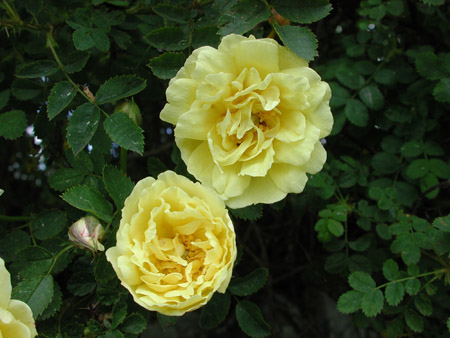
A double form
of R. x harisonii found by the author in Scotland
Some forms
of R. x harisonii have a pleasant scent similar to that of R.
spinosissima, while others have the less pleasant scent of R. foetida.
Some are so close to R. spinosissima in appearance that they are
only immediately distinguishable as R. foetida hybrids or seedlings
of such hybrids by their scent.
Other yellow
hybrids of Rosa spinosissima were raised in the 20th century using
rose species newly introduced from Asia. These include 'Albert Edwards',
which is a hybrid of R. spinosissima 'Altaica' with R. hugonis
that has single flowers of pale yellow (raised by Hillier Nurseries, Winchester,
in 1938), and 'Helen Knight', which is a hybrid of 'Altaica' with
R. ecae, having single, bright yellow flowers (raised by Frank Knight
at the RHS Garden Wisley in 1966 and named in 1978). 'Ormiston Roy'
is a hybrid with R. xanthina 'Allard'. It has single yellow flowers
and unlike the other two, has something of the habit of a Scots Rose. It
was raised in the Netherlands by Doorenbos in 1938. There are several other
more complex hybrids that contain R. spinosissima, such as 'Frühlingsgold'
(raised by Kordes in Germany in 1937) and 'Aïcha' (raised by Petersen
in Denmark in 1966). These beautiful roses have a relatively small percentage
of R. spinosissima genes ('Altaica' in these cases) compared with
other roses that I have mentioned. They are large shrubs with large leaves
and flowers. They bear no resemblance to the Scots Roses.
Pink,
red and purple Scots Roses
These include
hybrids between R. spinosissima and other native British species
plus hybrids with R. pendulina or, possibly, with pre-existing complex
coloured hybrids. These include several that could be said to be typical
Scots Roses - with foliage and habit similar to the wild R. spinosissima
of coastal Britain.
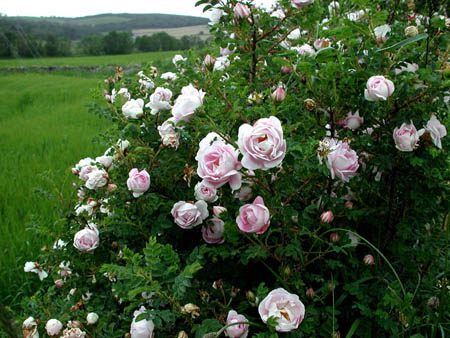
This fine semi-double
pink was found by the author in Aberdeenshire, Scotland
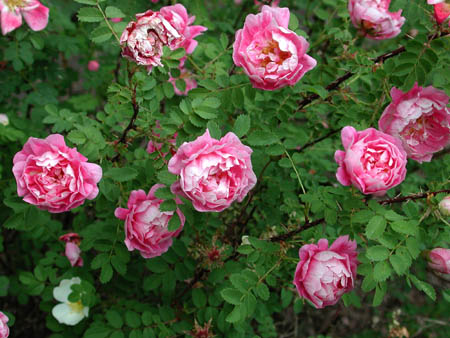
One of several
Rosa spinosissima cultivars in cultivation called 'Andrewsii
'Andrewsii'
is a name applied to several different pink, semi-double and double forms
in cultivation, one of which was awarded the Royal Horticultural Society
(RHS) Award of Garden Merit. 'Bicolor' was a name applied, in the
early 19th century, to a semi-double Scots Rose that was bicoloured in the
same sense as R. foetida 'Bicolor', but the petals are purple on
the front and white on back (see also 'Mary Queen of Scots'). There are
cultivars given the name today that are very different, with pink markings
on white petals. The old meaning of the name should have priority. 'Dominie
Samson', as sold in the United States, is a low growing cultivar with
double marbled pink flowers. The original plant with this name was raised
in the 19th century in Britain and named after a character in the novel
Guy Mannering (1815) by Sir Walter Scott. However, in common with many other
roses, the 19th century description is insufficiently detailed to be sure
that the plant sold today is correctly named. 'Doorenbos Selection'
is a low growing cultivar with striking single crimson flowers that was
apparently raised by Doorenbos in the Netherlands in the 20th century but
I have not yet traced the details of its origin. This rose, which I have
seen growing in California, has the characteristics of a true Scots Rose
in its foliage, stems and fruits but I have not yet seen it in flower. Double
Blush and Double Pink are names that are sometimes styled as
cultivar names. They have been applied to numerous different semi-double
and double forms. 'Falkland' is an attractive double shell pink with
greyish foliage and one of my favourite roses. Marbled Pink is another
name that is applied to several pink single, semi-double and double forms
in cultivation, some of which are more marbled in a true sense than others.
'Mary Queen of Scots' as described by Graham Thomas in Shrub Roses
of Today (1962) is a typical Scots Rose with distinctive white or grey
buds opening to semi-double purple flowers with white backs to the petals.
It is similar to the rose called 'Bicolor' in the early 19th century and
I have not found the name 'Mary Queen of Scots' used before the 20th century.
This semi-double rose, sometimes sold under the name 'Queen Mary'
by nurseries in Europe, is quite different from the single rose described
by Peter Beales in Classic Roses (1997) - see the description of the R.
x reversa group which is further on. 'William III' is a name applied
to several different deep pink to rich purple semi-double and double cultivars.
I have not found the name used before the 20th century.
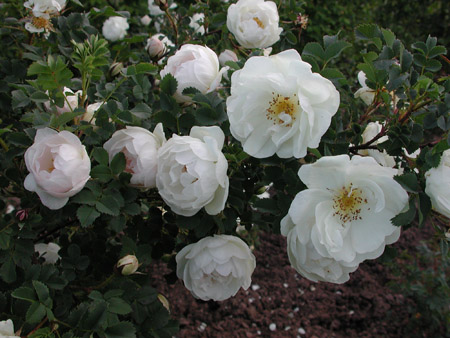
A semi-double
blush Scots Rose that fades to white
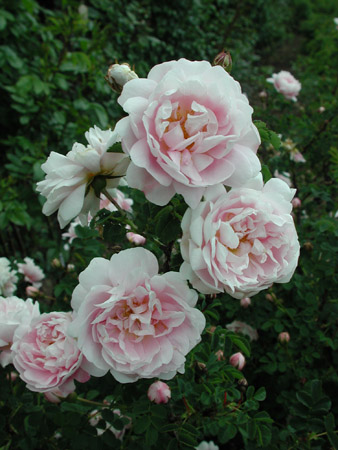
One of the many
'Double Blush' cultivars.
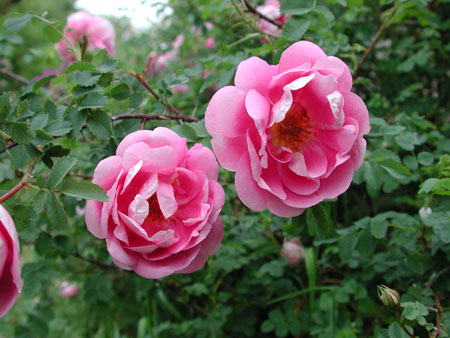
A particularly
good semi-double pink that will be called 'Glenhighton' after the garden
of the late Iris Strachan near Peebles, Scotland who gave me propagating
material
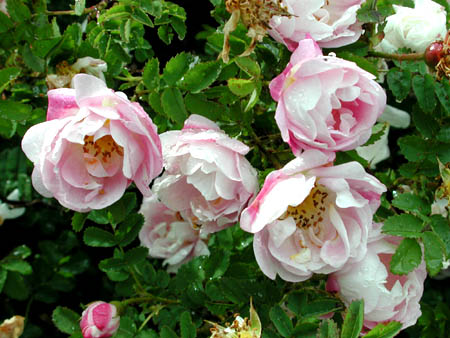
A semi-double
marbled Scots Rose found by the author near Peebles, Scotland.
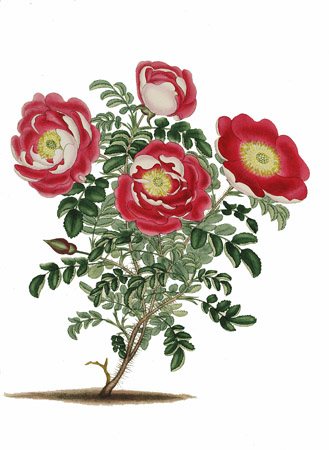
Illustration
of 'Bicolor' from Roses: or a Monograph of the genus Rosa by H. C.
Andrews 1828. courtesy RHS, Lindley Library, London.
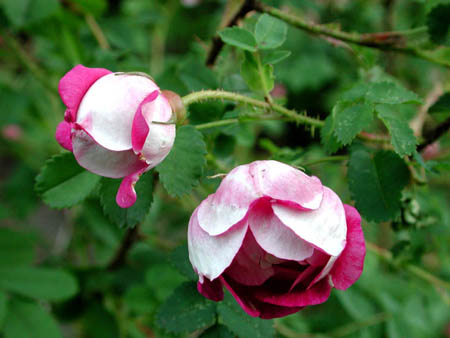
The
bicoloured buds of one of the roses known by the name 'Mary Queen of Scots'
- not to be confused with the cultivar of Rosa x reversa with the
same name. 'Bicolor' in the 19th century use of the name
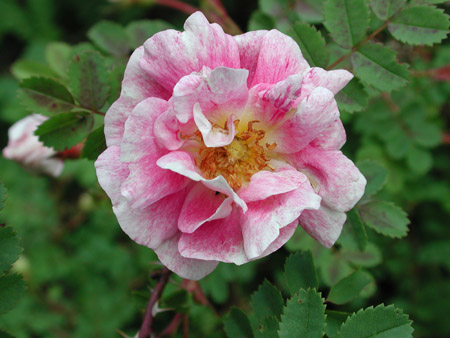
One of the Scots
Roses known today as 'Bicolor' - very different to the 19th century use
of the name

One of the cultivars
known as 'William III' forming mounds of purple at Crathes Castle, Aberdeenshire,
Scotland
I am not
sure whether to include 'Single Cherry' with this group of typical
Scots Roses or with the following group. It is one of my favourite cultivars
with its rich cherry-red, single flowers with paler backs to the petals
(a single 'Bicolor') but it is not a completely typical Scots Rose. It does
have the stems and black fruits of the species but the foliage looks as
if another species is involved. Also, it often bears more than one flower
at the end of each shoot, which suggests a hybrid origin. It is known as
'Red Nelly' in Europe.
Some pink
and red Scots Roses are even less 'typical' for one reason or another but
are still treated as Scots Roses. They include a spectrum of forms rather
than a closely defined assemblage.
The Rosa
x hibernica group covers hybrids with R. canina. The hybrid was
first recognised in Ireland in the early 19th century, hence the name. One
cultivar has fairly large, single, pink flowers and looks more like R.
canina than R. spinosissima. However, such hybrids have occurred
more than once and there is more than one rose in commerce under the name.
Roses of the section to which R. canina belongs produce very different
hybrids depending on whether they are the pollen parent or the seed parent,
and there are probably more Scots Roses with the same parentage but tending
towards R. spinosissima.
The Rosa
x reversa group covers hybrids with R. pendulina. They often
have smooth or bristly reddish stems with few or no prickles, a taller more
upright habit of growth, and less suckering. The crimson or pink flowers
often have a white centre and elongated reddish fruits. Some variants have
single, semi-double and double flowers. They start to bloom slightly earlier
in the season than other Scots Roses. Most cultivars of R. x reversa
tend more towards R. pendulina than R. spinosissima in habit
and lack the scent of the latter, but some do lean more towards R. spinosissima.
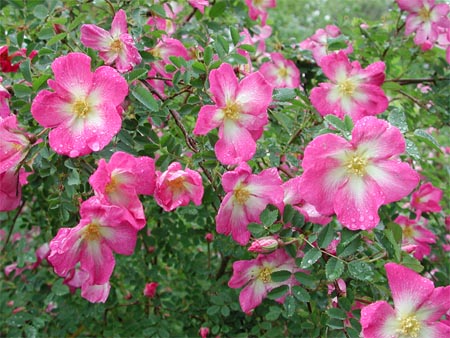
Rosa
'Glory of Edzell' is an early flowering hybrid
'Glory
of Edzell' is one of the first Scots Roses to flower in the spring.
A mature plant gives the appearance of a cloud of pink butterflies when
in bloom. The flowers are pink with a feathered star of white. The name
'Mary Queen of Scots' is used by Peter Beales in his book Classic
Roses (1997) for what seems to be a cultivar of R. x reversa
with single pink flowers with irregular, darker pink shading and elongated,
deep red fruits. This is quite different from the semi-double purple Scots
Rose with this name described by Thomas (1962) and previously discussed.
Unfortunately, it is the single-flowered plant that is normally sold by
nurseries under the name 'Mary Queen of Scots'. However, the name as used
by Graham Thomas has priority. Ideally, the name of this single flowered
cultivar should be changed. It flowers early, at the same time as 'Glory
of Edzell'. 'Mrs Colville' is a name applied to several different
single and semi-double cultivars having rich velvety crimson blooms with
white centres. The glowing colour of these roses, which include some of
my favourites, is particularly striking. They are probably cultivars of
R. x reversa, and some tend more towards R. spinosissima in
their habit and other characteristics than to R. pendulina, while
for other cultivars it is the other way round. 'Poppius' is an early
flowering double pink cultivar of R. x reversa raised by Carl Stenberg
in Sweden in about 1850. It is named after a Finnish botanist, Dr. Poppius.
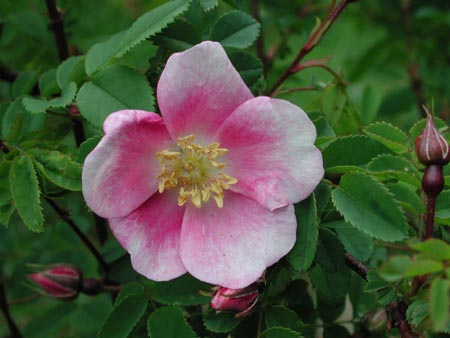
The variant
of Rosa x reversa called 'Mary, Queen of Scots' with single flowers
is unlike the semi-double typical Scots Rose cultivar of the same name
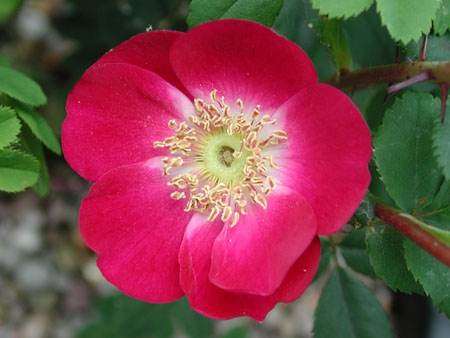
One
of the Scots Roses known by the name 'Mrs Colville' – one of several hybrids
between R. spinosissima and R. pendulina
Pink or
red complex hybrids of Rosa spinosissima bear little resemblance
to Scots Roses. They include 'Lochinvar', a repeat-flowering, double,
pale pink R. spinosissima hybrid which was raised by David Austin
in 2002, and 'Robbie Burns', a single pink hybrid between 'Wife of
Bath' and R. spinosissima, introduced by Austin in 1986. The old
'Stanwell Perpetual', thought to be a hybrid between R. spinosissima
and an Autumn Damask rose, was supposedly discovered as a self-sown seedling
in 1838. It is repeat-flowering, with pale pink double flowers that fade
to white and a delicious scent - but not that of R. spinosissima.
Unlike the other two, this hybrid would have involved the native form of
R. spinosissima but this is not very apparent in its appearance.
The pink and red Kordes hybrids such as 'Frühlingsmorgen' (1942)
and 'Frühlingszauber' (1942), like others of the Frühlings Series,
involved 'Altaica' in their breeding and are unrelated to Scots Roses in
origin and appearance.
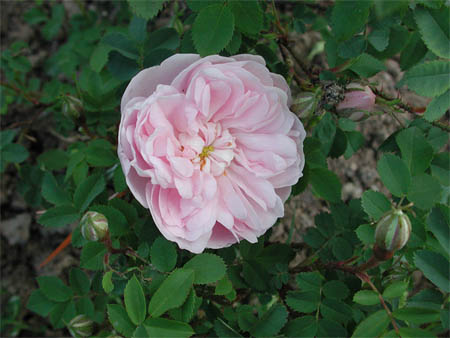
Rosa
'Stanwell Perpetual' has good scent and delicately coloured flowers that
fade from pink to white
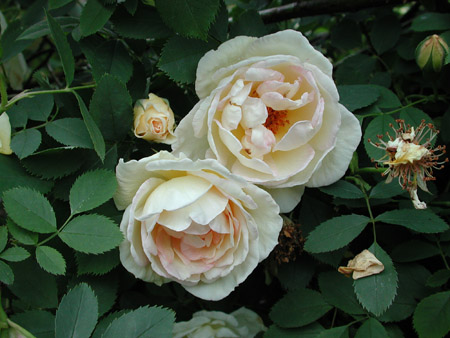
Rosa
'Frühlingsduft' and other Frühlings roses have much larger flowers than
true Scots Roses
Conservation
of Scots Roses and other Spinosissimas
I have been
exploring old gardens in Scotland and elsewhere for some years, searching
for surviving Scots Roses. Many of those in my own collection of about 300
cultivars and related hybrids have been propagated from plants in old gardens,
while others have been obtained from nurseries or friends in Britain and
other countries. The National Council for the Conservation of Plants and
Gardens (NCCPG) awarded my collection Full National Collection status in
2006. I have been proactive in conserving old varieties of Scots Roses,
and this is probably the largest collection in the world.
To raise
awareness of this group of roses and to encourage their conservation by
private gardeners and those responsible for public collections, I have published
a number of articles for specialist journals and gardening magazines in
Britain, France, Germany, Finland and the United States. In addition, I
am writing a book on the history, nomenclature and cultivation of Scots
Roses and other Spinosissimas that aims to be a fully referenced definitive
source of information for garden historians and rose lovers.
My research
has allowed me to assist with the identification of Scots Roses and other
'Pimpinellifolias' at the Europa-Rosarium at Sangerhausen in Germany, at
the Roseraie du Val-de-Marne at l'Haÿ-les-Roses near Paris in France, and
elsewhere. This has revealed the fact that in some cases the name of an
old rose variety has only survived on a label while the variety itself has
been lost during the life of the garden concerned.
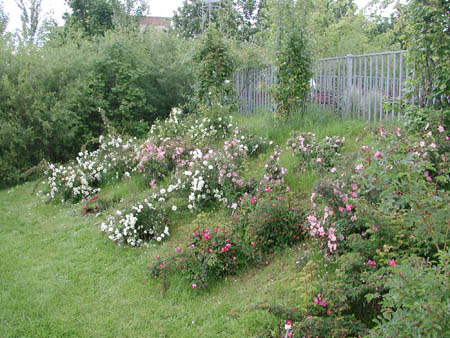
A grassy bank
at the Europa-Rosarium, Sangerhausen, Germany planted with Spinosissimas
In Britain,
hundreds of named varieties of Scots Rose were available in the 19th century.
In North America, the numbers available commercially were smaller but the
19th century catalogues of William Prince and other nurserymen provide some
indication of the cultivars that may still survive unrecognised in gardens
and cemeteries there. However, immigrants from Scotland and other parts
of Europe also introduced Scots Roses to North America, some of which may
never have been available commercially. Adding to the complexity, some nurseries
in Britain and America sold collections of mixed seedlings that never had
names and some individuals raised varieties that never had recorded names.
Self-sown seedlings appeared as well!
Therefore,
it should not be assumed that it is possible to link a found variety with
a 19th century name. However, some old cultivars that have not survived
in Britain or mainland Europe may have survived in North American botanic
gardens, private gardens, cemeteries and others sites. An individual Scots
Rose surviving in an old garden may be the last example of a particular
cultivar and therefore have a significance that may not be obvious. They
are worth conserving, even if in many cases we may never know their original
name! Several of the Scots Roses that I have found in old gardens and other
sites in Britain are worthy of wider cultivation and some may even be superior
to varieties currently in commerce. This may also be true of 'found' varieties
in North America.
Scots Roses
are significant and rather romantic survivals of a little-known historic
horticultural phenomenon and fashion. Once the province of wealthy landowners,
they became popular 'cottage garden plants'. Emigrants from Europe carried
them across the world to help them feel at home in a new country. As the
quotation from Anne of Green Gables suggests, the love of these roses
stayed with such immigrants and their descendents until they "passed on
to another land." However, Scots Roses are not just delightful souvenirs
of the past. They are being rediscovered by today's gardeners because they
have much to contribute to modern gardens and to the breeding of new disease-,
drought- and cold-resistant scented roses.

Peter D.A.
Boyd is the Collections Manager for Shrewsbury Museums Service in Shrewsbury,
Shropshire, England. He is also the representative for Northern Europe on
the Heritage Rose Committee of the World Federation of Rose Societies. His
personal collection of some 300 species and cultivars of Scots Roses has
been awarded National Collection status by the UK's National Council for
the Conservation of Plants and Gardens. For more information on Scots Roses,
visit www.peterboyd.com/scotsroses.htm.
Besides his dedication to preserving and popularising Scots Roses, Mr. Boyd
is also known for his research into Pteridomania and the life and work of
Charles Darwin who was a native of Shrewsbury. He created the multidisciplinary
Darwin Country website at http://www.darwincountry.org/ .
Contact
details:
Peter
D. A. Boyd
Curator
(Shrewsbury Museums), Shrewsbury Museum and Art Gallery, Barker Street,
Shrewsbury, Shropshire SY1 1QH
Tel: 01743
281205.
E-mail:
peterboyd@btinternet.com
* Information
on Peter D. A. Boyd's forthcoming book *
'Scots
Roses, Rosa spinosissima and other Pimpinellifolias'
